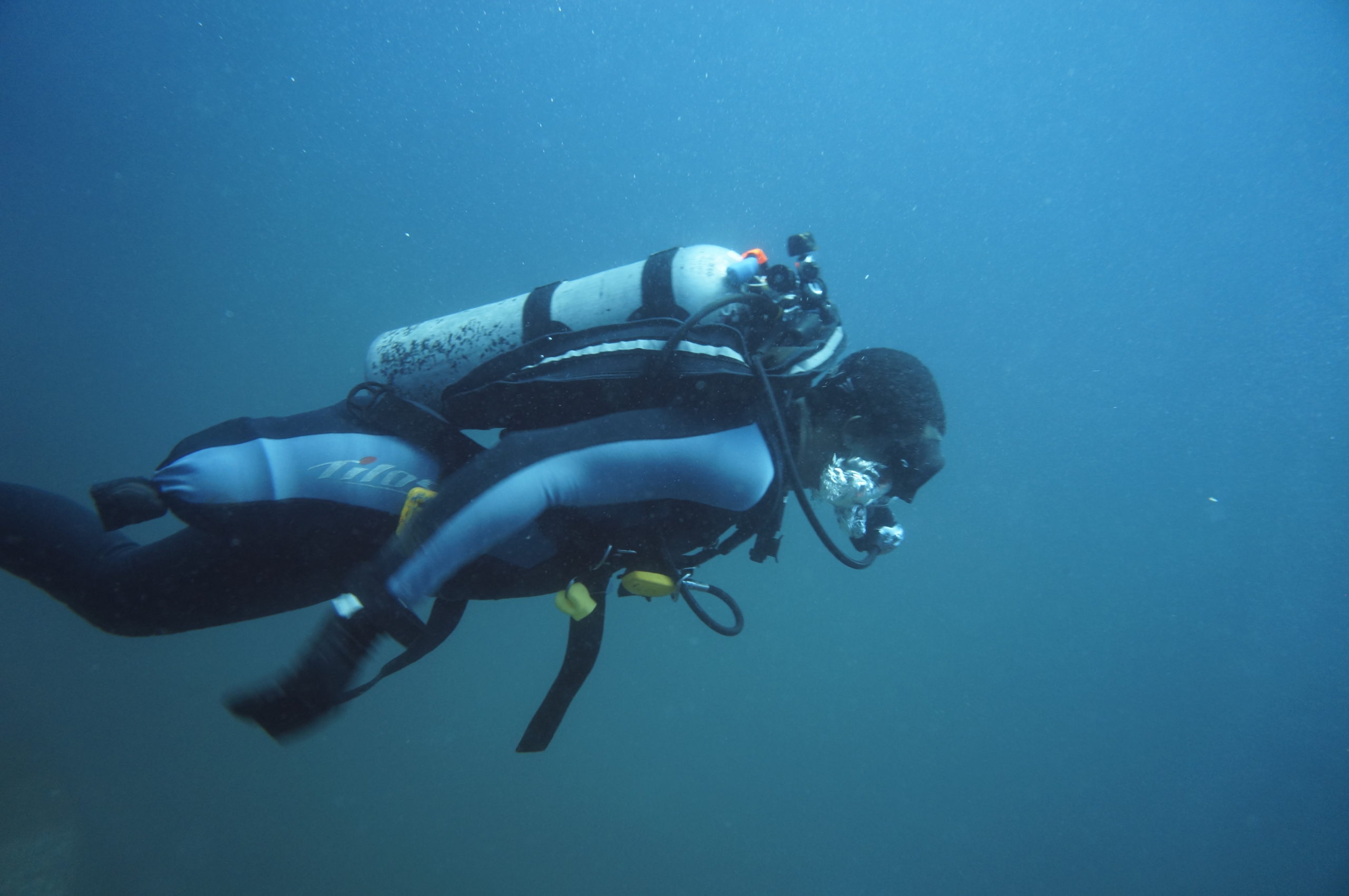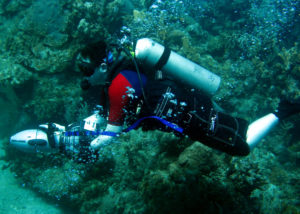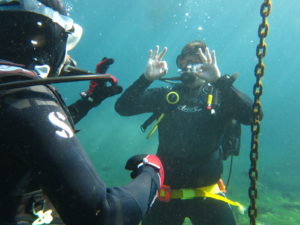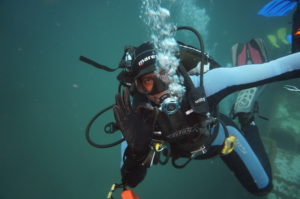
Scuba
Scuba is an acronym for Self Contained Underwater Breathing Apparatus. Although humans have been venturing underwater for more than 2000 years, it wasn’t until 1942 they were able to breathe underwater free from a surface supply of air. It was Jacques Cousteau, collaborating with French engineer Emile Gagnan, who developed the SCUBA.

Getting Started
To begin an exciting adventure into the world of scuba diving, the first step is establishing if you are fit to dive with a physical examination. This is true for everyone who wishes to take scuba diving lessons and it has nothing to do with physical disabilities. The purpose of this is to determine if a participant has any health conditions, such as heart conditions or lung disease, that make diving an inadvisable activity for the participant. However, a medical physician can approve diving for participants with certain health conditions.
Finding an Instructor
Seek out an instructor who has taken a crossover course for training and certifying individuals with disabilities. These courses teach the instructor about disabilities and how they relate to diving, as well as techniques for diving with disabilities. Additionally, the instructor learns how to compensate for the physical inconveniences various disabilities produce. What you don’t want is an instructor who teaches your disabilities to dive; what you do want is an instructor who will teach you to dive with your disabilities.
The Handicapped Scuba Association (HSA) has a directory of certified dive instructors and a directory of dive masters/assistant instructors who are able to teach you to dive.
Finding a Program Near You
If you are interested in learning how to scuba dive, check out these local Move United member orgnizations that offer scuba diving!
If there is not a chapter near you, contact the Handicapped Scuba Association, as they provide numerous programs throughout the country.
Equipment
Before you go out, make sure your are prepared by having all the equipment you will need.
Face Mask: The most important feature of a mask is that it fits properly. This is a very personal piece of equipment because it is on your face and is your window to the sea. A low volume mask allows better vision and it is easy to clear of water if it floods. Some masks are equipped with a purge valve that makes clearing the mask of water hands free, a benefit for those with hand disabilities, but also convenient for any diver. Neoprene mask straps are also convenient, especially if the diver has hand limitations, because they slide over hair smoothly without snagging.
Snorkel: The most important feature of a snorkel is how easy it can be cleared of water. To clear the snorkel, blow a puff of air into the tube and blow the water out. Snorkels with purge valves drain out through the purge at the bottom and requires a very small puff of air. These snorkels are a good choice for all divers.
 Regulators (equipment that allows you to breathe underwater): Major brand regulators are well built and have very few malfunctions when properly cared for. This is a matter of deciding what features you want and how much you want to spend. Regulators should be serviced annually. If not used for a year or more, have it serviced before diving.
Regulators (equipment that allows you to breathe underwater): Major brand regulators are well built and have very few malfunctions when properly cared for. This is a matter of deciding what features you want and how much you want to spend. Regulators should be serviced annually. If not used for a year or more, have it serviced before diving.
Back-up Air Source: The most common, and the safest, is the octopus back-up regulator. This is an extra second stage regulator (the component you place in your mouth to deliver the air you breathe from the tank). This is very convenient because in the unlikely event of an out-of-air emergency, you simply hand this to the person who is out of air and you are completely unaffected.
Fins: If you use fins but have some weakening of your legs, there are fins that give the thrust on the downward kick with little to no resistance on the upward kick.
Adaptive Scuba Prosthesis: Non-corrosive and drains well; allowing amputees to attach a fin to their residual limb.
Webbed Gloves: If you swim with your hands, webbed gloves are readily available and provide about 50 percent more thrust per stroke than without them. They come in a variety of styles and sizes. Some are neoprene and provide warmth and some are made from lightweight materials for dexterity.
Buoyancy Control Device (BCD): This is a very important piece of equipment, because it floats you at the surface and underwater. When you are neutrally buoyant underwater, you are floating underwater. This is important for both comfort and safety. When choosing a BCD, be sure to get one that floats you properly at the surface and underwater. Back inflation BCDs are designed for overhead environments and float you face down underwater, but the problem is they do the same thing at the surface. In an emergency this is very dangerous. Traditional BCD design with quick release shoulder straps are the best. They easily float you upright, on your back, or in the face down prone position at the surface and underwater. Some BCDs are equipped with a pneumatically-assisted deflation device used to deflate your BCD, useful for someone with a hand disability.
Scuba Tanks: There are different types of tanks, also called cylinders. Consider the effect the tank will have on your buoyancy trim. Heavy steel tanks will roll you onto your back, especially if you have a spinal cord injury. Aluminum 80s, by far the most common at dive resorts, and steel 63s are the best for most divers.
Exposure Suits: There are three main types: wet suits made of neoprene, semidry suits also made of neoprene, and dry suits made of crushed neoprene and other materials. The most common is the wet suit, made of different types of neoprene and in different thicknesses depending on the temperature of the water they will be used in. Most are now made from super stretch neoprene and are very easy to pull on.
If it is difficult for you to get into a wet suit, you can have zippers built into the suit along the legs and sometimes along the arms to make it easier. Also available are suits with gussets along the side, legs, hips, torso, and arms for easy donning. All exposure suits can be ordered with custom features to accommodate amputees and spinal cord injured divers. Pockets can be built-in for weight distribution or additional padding for scooting on your butt.
Protective Gear: For divers who cannot feel sensation on their extremities, wetsuits and diving boots can help protect from abrasions and lacerations during the dive.
Scooter: Helps propel and move through the water and is particularly helpful for those with lower limb impairments.
Safety First: Always dive with a buddy who can assist you in case of an emergency. The HSA has a directory of Dive Buddies who are available to dive with you.
Adaptive Water Equipment Suppliers
Certification
Physical Performance Requirements
To become a certified diver through the Handicapped Scuba Association, you must first meet Physical Performance Requirements as outlined by the HSA and other diver training agencies, such as the Professional Association of Diving Instructors (PADI) and the National Association of Underwater Instructors (NAUI). These are simply required skills that must be performed for certification.
Multi-Level Certification
Once you go through the HSA Physical Performance Requirements, you are given a certification level based on your performance so your needs are best accommodated. The classification system mainly affects the Buddy System and who you are able to dive with.
 Below are the various levels of certification by the HSA.
Below are the various levels of certification by the HSA.
Level A – The diver has shown, by successfully challenging these Performance Requirements, that he can perform the skills required to be an effective Buddy and are certified to dive with one other certified SCUBA diver.
Level B – The diver is certified to scuba dive with two dive buddies who are certified Open Water Level A or above divers.
Level C – The diver is certified to dive with two dive buddies, one certified Level A or above, and an HSA Dive Buddy or, at a minimum, a certified Rescue Diver through PADI.
To learn more about each certification, visit the HSA’s Learn to Dive page.
Diver Certification Classes
The Handicapped Scuba Association provides certification classes of various levels to help you best reach your diving goals!
Becoming and Instructor
Already an experienced diver? Consider becoming an HSA-certified instructor, assistant instructor, dive master, or dive buddy!
HSA Dive Instructor, Assistant Instructor, and Dive Master Certification Information
HSA Dive Buddy Certification Information
To Learn More
Overseeing Organization for Adaptive Diving- Handicapped Scuba Association
Scuba Diving Credentialing and Training Organization- Professional Association of Diving Instructor
Scuba Diving Credentialing and Training Organization- National Association of Underwater Instructors

